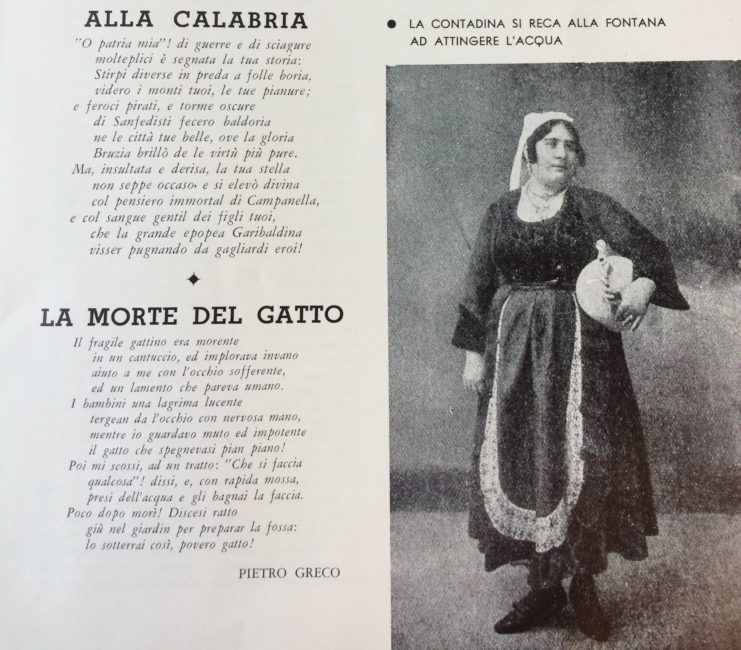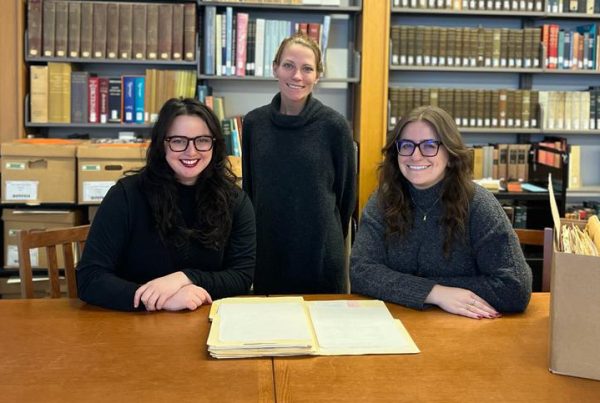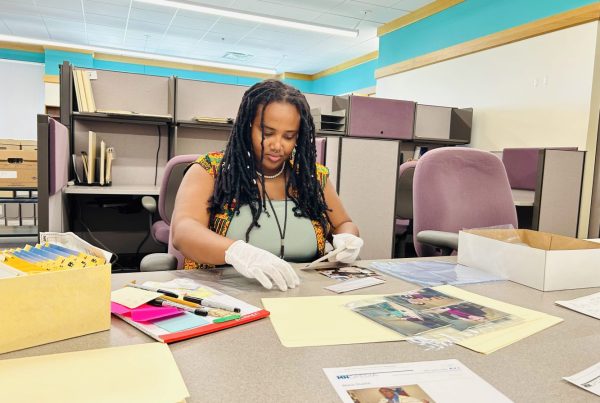Spotlight on Research: Guest author Aurora Moxon was awarded the Immigration History Research Center Archives (IHRCA) Grant-in-Aid Award this past year, and visited us for five days to study the research topic of Italy’s Other: A Study of Transnational Calabrian Identity. This blog post shares her recent experience with the IHRCA. Moxon is a History Ph.D. candidate at the University of Bristol, U.K.
Background to my research on Calabria
The starting point of my research on Calabrian identity is Calabria’s position in the national collective imaginary as Italy’s most extreme region in terms of socio-economic status, in terms of crime, and in terms of its proximity to cultural ‘otherness’ and the global South. Today Calabrian scholars and thinkers often describe the region as having the highest unemployment levels within Italy, the highest poverty rate, and amongst the highest rate of emigration. At the same they argue that in the mainstream Italian media the persistent saturation and stereotyping of crime in the region presents a homogenous image of Calabria as ‘una zona del male’ (‘a bad region’, Mimmo Nunnari 2017: 24).
In fact, the region’s socio-economic conditions have often been understood as being ‘inherently’ Calabrian. This way of thinking has also been employed historically to understand the Italian South; it originated in the works of Grand Tourists who ventured South to discover the remnants of the ancient classical world, but also to come into contact with an exotic ‘other’ within the boundaries of Europe and the West. This way of seeing the South as essentially ‘other’ was bolstered at the time of Italian Unification in 1861 by the racial theories of Cesare Lombroso and Alfredo Niceforo who argued that the South’s socio-economic conditions were in part the result of Arab and African racial patrimony. These positivist criminologists believed that such racial patrimonies meant Southerners were predisposed to certain types of behaviour, and especially certain types of crime, since they were supposedly further down the evolutionary scale than the more evolved Arian races of the North. Even today these ideas resurface in popular representations of Calabria such as the 2011 film Qualunquemente (Qualunquemente translates as ‘whateverly’, reflecting the trope that Calabrians are unable to speak Italian) in which corruption and criminality in the region are both presented as inherent to Calabrian psychology and culture, as well as being the cause of national political and economic problems.
In my Ph.D. thesis, I am focusing on archival material, oral histories, and literary outputs to explore how the negative discourses have determined Calabrian self-perception and self-representation. Are Calabrians today ashamed of their Calabrian identity, and in particular the Arab and African influences that are marked as ‘other’ with respect to northern European culture, and if so, how does this shame manifest itself? Given the mass emigration of Calabrians away from the region in particular to northern Europe and the western world where they have been met with similar racialised discrimination, my research considers Calabrian identity and shame in its transnational context. The aim of this is to understand whether and how a sense of shame becomes transnationalised within the diaspora and how this can be understood alongside Calabrian self-perception and representation in Calabria.
Material relating to the Calabrian diaspora in North America located at the Immigration History Research Center Archives (IHRCA)
The IHRCA is host to a wealth of material documenting the lives of Calabrians in both the U.S. and Canada. An original newspaper, La Calabria, published in New York in 1938, was a particular highlight of my archival research, but I was also overwhelmed by the volume of literary material produced by the Calabrian diaspora and held at the IHRCA. During my week’s stay I consulted original manuscripts of essays, plays and novels written by Calabrian Americans such as Alessandro Sisca and Pietro Greco, rare academic work on the Calabrian diaspora, various issues of the journal I calabresi nel mondo, and other material. The Diego Delfino papers which contain letters sent between a Calabrian doctor working in the U.S. and his young daughter back in Calabria were another highlight; I was not prepared for the shocking murder of Delfino as I traced their emotional correspondence. This was a poignant reminder to me that I am exploring the real experiences of individuals and the multiple losses they have endured in their personal narratives of migration. (These letters are also included in the Digitizing Immigrant Letters project; see https://ihrca.dash.umn.edu/dil/)
Key surprises thrown up in this archival research
While reading the 25th June 1938 issue of La Calabria, I was initially surprised by its pro-fascist agenda. However, as I moved on to read a pamphlet written for a charity event held in New York in 1949 to raise funds for fellow paesani (countrymen) struggling in dire post-World War II conditions in Calabria, I was struck by the identical rhetoric employed in both documents to stir up a sense of pride in Calabrian patrimony amongst the Calabrian community in the U.S.. While La Calabria ostensibly served the Calabrian diaspora with news from back home, various articles and an editorial published in this issue pleaded with the paper’s readers as heirs of Magna Graecia (and therefore the origins of Western civilisation) to demonstrate their cultural dignity by supporting the fascist cause. Eleven years later and that plea to the Calabrian diaspora was being replicated, this time to support Calabrians back in the paese, once again through emphasis on the ancient noble character and identity of Calabrians. A perfect demonstration of this utilisation of Calabrian identity as a resource for these ideological agendas is the use in both texts of the same image of ‘una contadina calabrese’: a photograph of ‘a Calabrian peasant woman’ with her ceramic water vessel taken in a studio. Exploring the ways in which Calabrian identity is both celebrated and delineated in these patriotic appeals, especially in terms of what aspects of that identity were being highlighted and, conversely, what aspects were being silenced or ‘whitewashed’, is particularly significant for my research.

Image of ‘la contadina,’ printed alongside poetry in Calabrese dialect by Pietro Greco, in a charity pamphlet. (Calabria Nostra: Pace e Lavoro. Special publication issued by American Aid to Calabria in collaboration with American Relief for Italy on the occasion of Fundraising Dance at the Commodore Hotel New York April 8 1949, p. 11, available at the IHRCA)
Conclusion
I would like to thank the IHRCA for making travel to them possible through the Grant-in-Aid program. While I could have spent years studying relevant material on the Calabrian diaspora held in the archives, this intensive five-day research period developed my understanding of what it meant to be Calabrian in the U.S. during the 19th and 20th centuries. It also made me appreciate how the diaspora maintained links with Calabria and, conversely, how Calabrians understood their region once they had left it. As I go on to investigate Calabrian identity in Australia, the research undertaken at the IHRCA will provide me with a well-grounded framework for analysis of the experiences of the Calabrian diaspora in its transnational context.





Hello, I’d like to point a small error in the figure description
“Image of ‘la contadina,’ printed alongside poetry in Calabrese dialect “.
Both poetry pieces shown in the picture are written in standard Italian Language, not in any of the many Calabrese dialects, whoose vocabulary and grammar are strongly different from what is depicted.
Thanks for bringing this topic up, and farewell